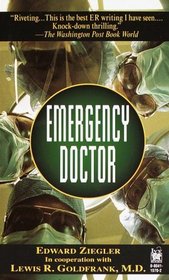Helpful Score: 4
This book follows an experienced emergency physician who has managed to do something very rare in his field: continue to see the humanity in every patient he encounters. Bellevue Hospital in 1980's Manhattan was one of the first major hospitals to see AIDS patients regularly. These patients were treated well in Dr. Lewis Goldfrank's emergency department, along with the mentally ill, destitute, traumatized, and otherwise maimed patients who came through the door. Every patient has a story worth hearing, and every patient is worth hearing about.
Helpful Score: 1
This is an excellent book. If this is your genre you will really enjoy it. It not only tells about his day to day life in the emergency room, but also about the different illnesses, accidents, etc that he deals with. I think this is one of the better books I have read on this genre.
Like reading an episode of ER but with a bit more scientific explanation. It is interesting.
This is a very educational book if you are intrested in learning about the ER and how it works. Honestly, I was hoping for more entertainment (kind of like the TV episode "ER," it has drama mixed with the educational medical stuff). I didn't find this book very entertaining, just straight forward educational on medical ER work.
THe nurse in me loved this book. It is a collection of stories from a 1970's ER.
The ER at Bellevue Hospital is the setting for doctors fighting around the clock to save lives learning how to make quick decisions in real life and death drama.
I *LOVED* this book. Not only does it cover many fascinating cases in Bellview Hospital in New York, it also talks about the new science of Emergency Medicine as its own field of study. The book was originally written in 1987 when AIDS was becoming acknowledged as a world-wide epidemic, so to read about AIDS and AIDS-related diseases back then is a terrific detail on the history of the disease. For instance, did you know that AIDS was originally called GRID (Gay Related Immune Deficiency) by the Medical community, because in the infancy of the epidemic it was almost exclusively seen in gay patients? (IV drug users soon showed the disease to be much more wide-spread.) This book also goes into fascinating detail about exactly what happens to the body during certain medical emergencies: *Why* an extreme allergic reaction to peanuts, for example, will kill, or what happens during hypothermia. The 8 page glossary at the back of the book helps any layman understand the medical terms.
The new edition has a great last chapter that Dr Goldfrank wrote in 2003 to mention many of the changes in emergency medicine during those years. A fascinating, well-written book that I highly recommend to anyone who has even a passing interest in medicine and its recent history.
The new edition has a great last chapter that Dr Goldfrank wrote in 2003 to mention many of the changes in emergency medicine during those years. A fascinating, well-written book that I highly recommend to anyone who has even a passing interest in medicine and its recent history.




